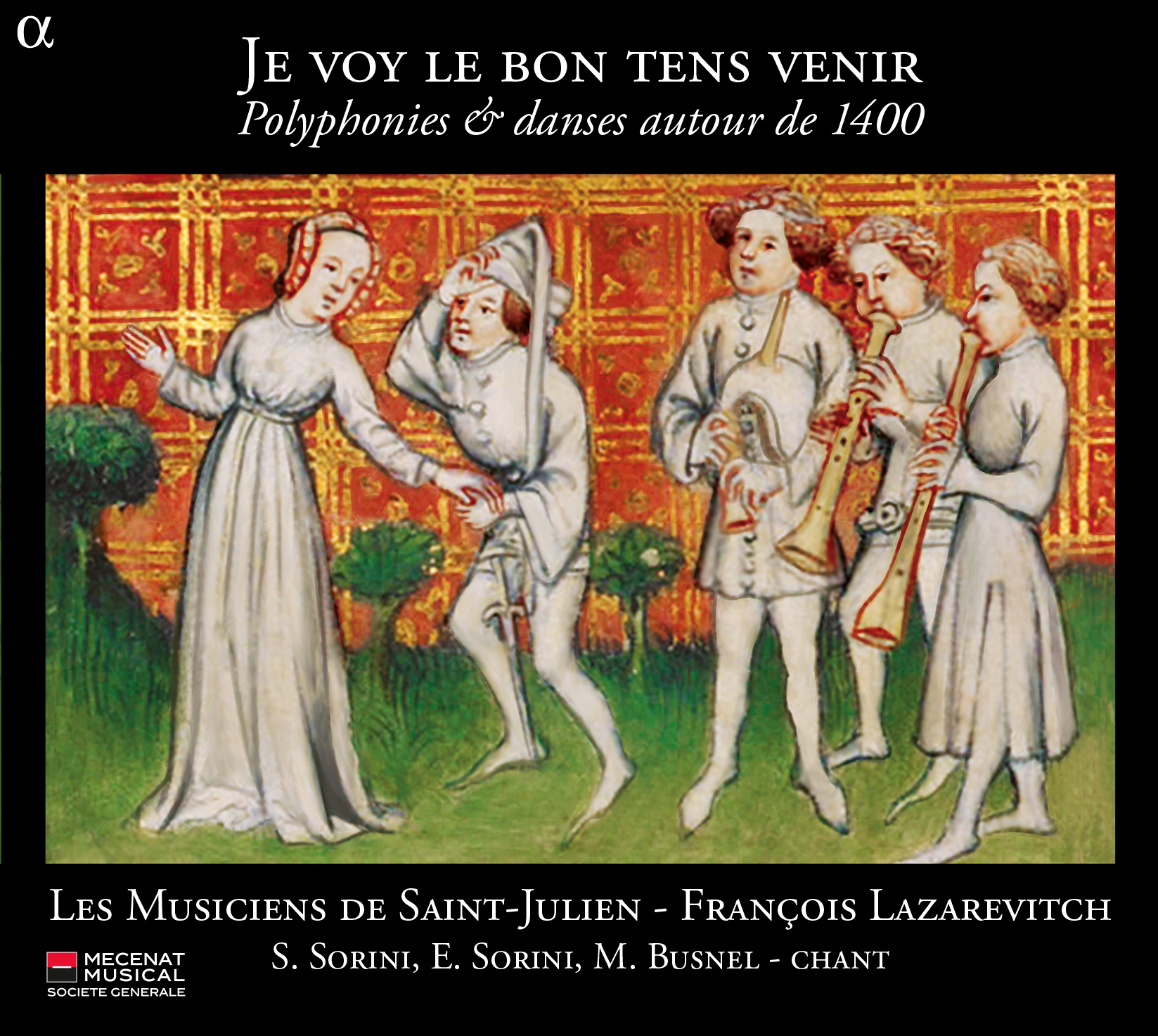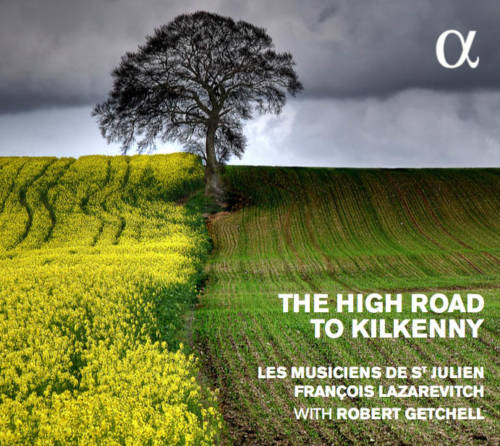Je voy le bon tens venir
Polyphonies & danses autour de 1400
Tracklisting

 Diapason d’or
Diapason d’or Le choix de France Musique
Le choix de France Musique
Alpha productions • Alpha 189 • ISBN 3760014191893 • 1 CD • 1 h 06
- Kere Dame – Je voy le bon tens venir (4:29)
- Ce jour de l’an (3:44)
- Donne moy de ton pain bis – Allons Commenchier – J’oÿ les clés (1:31)
- Mal vi loyauté (3:38)
- Et je ferai (3:20)
- Je commence – Et je feray – Soules viex (3:08)
- Tres gentil cuer (3:47)
- En ce gracieux tamps (2:54)
- Tant plus vos voye – E dieus, conment j’ay grant desir (3:09)
- Soit tart tempre – Ja falla – En ties, en latim (3:52)
- Gli atti col Dançar (4:47)
- J’ay grant desespoir – J’ay grant espoir (5:22)
- Tres douche plasant bergiere – Reconforte toy, Robin (4:23)
- L’escu d’amors (2:21)
- Un fait d’armes (1:06)
- Pour dieu vous pri (2:09)
- Tres dous compains (3:27)
- Bergeronnète – Robin, par l’ame ten pere (2:35)
- Robin muse – Je ne say fere (2:00)
- Prenés l’abre Peyronelle (4:18)
Listen to the disc
About
Distribution
François Lazarevitch : flutes, smallpipes, organetto & direction
Simone Sorini : tenor, lute
Enea Sorini : baritone, dulcimer, drums
Marc Busnel : bass
Angélique Mauillon : harp
Nicolas Sansarlat : bowed fiddle, rebec, key bombard, chalemie
Julien Léonard : bowed fiddle
Sandie Griot : sliding trumpet
Les Musiciens de Saint-Julien have integrated a living art of rhythmic swinging, of slightly swaying supports, which one did not expect in the complex rhythms of a Senlèches virelai, but which works wonders.
isabelle ragnard – diapason
Press
may 2013
Diapason – Diapason d’or
Isabelle Ragnard
For the sixth part of the collection “A thousand years of bagpipes in France”, The Musicians of Saint-Julien venture to medieval territories, which they travel with the same happiness as the paths of the Renaissance and the Baroque (“ And the flower flies”, Diapason d’or, cf. Here, François Lazarevitch takes the Game of Robin and Marion by Adam de la Halle (13th century) as his breadcrumb trail and unearths rare pieces with more rustic themes in the maze of manuscripts from the end of the 14th century and the beginning of the 15th century. how courteous. Tasty little polyphonic motets and virelais break with the clichés of a musical period often reduced to the sophisticated discoveries of the “ars subtilior”. Among the curiosities, we note the song Prenés l’abre Peyronnelle (quoting the chorus “Hey wake up, Robin!”) or the motet Je commence/Et je faire/Soules viex, which is a collage of bits of dialogue and cries of peddlers close to the musical “fricassees” of the 16th century.
With three singers shouting in full voice, the canon Tres dous compains, of which there were only instrumental versions, demonstrates all the evocative force of the onomatopoeia used in falconry. From a fine-tuned program so that the ear is not too quickly tired by the bagpipes, we only regret that the extreme ranges are served by the spatialization of the voices; undoubtedly happy in concert, the distance effect is confusing here. Everywhere else, what art of colors and dosages! The brilliance of the bagpipes is reflected in the fine light of the fiddle and the rainbow of the tympanon, the harp, the chalemia, the rebec, a slide trumpet… The (nuanced) roughness of the Instrumental timbres act as a revealer for more well-known pieces. The melodies with astonishing inflections (Soit tart tempre) gain strength thanks to the beautiful sonic presence of the bagpipes, while the perception of the breath in the Indian bansuri flute adds a gentle warmth (Gli atti col dançar). The influence of traditional musical practices is noticeable, but without “picturesque” facilities. Through their experience of ancient dance balls, the Musicians of Saint-Julien have above all integrated a living art of rhythmic swinging, slightly swaying supports, which one did not expect in the complex rhythms of a Senlèches virelai, but which works wonders.
may 2013
ClassiqueNews.com
Camille de Joyeuse
Je voy le bon tens venir : this is an adage that warms hearts in such a crisis […] but also captivates the senses. Could we hope for such a beautiful poetic recording, sublimated by its subject, evoking the thousand graces of better times? […] A whole world of sound emerges here, under the sparkle of the combined timbres, joined by the 3 explosive male voices of the soloists associated with the instrumentalists of the Musiciens de Saint-Julien. Spicy, lively, choreographic too, each sequence of this enchanting disc reveals without affectation or artificial effects, the eloquent diversity of the sources of inspiration: dialogues, melodies, virelais, ballads and motets find the natural and characterized rhythm of the polyphonies and dances around from 1400 (the subject of the program): they gain an additional fascinating intensity thanks to the articulate and flexible gesture of the Saint-Julien. The bagpipes like the magic flute (I grant despair, track 12) by François Lazarevitch are not the least active, even miraculous, facet of this captivating record with countless treasures and surprises. A shock.
may 2013
Classica – 3 étoiles
Guillaume Bunel
With this disc devoted to the theme of Robin and Marion around 1400, Les Musiciens de Saint-Julien do not fail to surprise us: we thought they were fans of the repertoires of the 17th and 18th centuries: here they are plunged into the Middle Ages, continuing their remarkable work of linking written repertoires and oral traditions, with the vitality and inventiveness which is customary to them. This recording contains very beautiful ideas, which are reminiscent of the work of the Micrologus ensemble, also versed in these repertoires, in an approach combining popular practices and written repertoires. However, the whole disc is singularly lacking in unity. Most of the musical choices immediately seduce, the rhythmic nervousness of the voices as much as the suavity of the flute, the vigor of the “alta capella” as well as the expressive restraint of the harp…
april 2013
Musiques-medievales.eu
Christian Brassy
This recording is intended to be the medieval stage of the “1000 years of bagpipes in France” project that François Lazarevitch has been leading for several years. A medieval world which is not foreign to him: he had trained in this music in particular with the Micrologus ensemble and he still regularly participates in the program “The Game of Robin” by Adam de la Halle.
It is this same theme of “Robin and Marion” which is taken up here, as Adam’s successors were able to approach it at the end of the 14th century. The opportunity, as in the other programs of “1000 years of bagpipes”, to bring together different musical universes: the saucy echoes respond to the courtly delicacy, the dances of popular inspiration with the songs of chiseled polyphony, the bursts of ‘a band of senior fiddlers in the intimacy of fiddle, harp and lute. The pieces chosen are from very varied sources: there are as many songs from the most subtle composers of the 14th century ending as Ciconia, Solage or Matteo de Perugia, as well as the lively themes of little-known Virelais when it is not the theme from “Robin, by the soul of your father” treated in polyphony. Some are revelations like this surprising motet “I begin my song”… of which I will leave you the surprise.
François Lazarevitch, as always, alternates brilliant virtuosity and expressive finesse, whether on the bagpipes or the transverse flute; he even ventures here to play the organetto. For the occasion, he called on two associates he met within Micrologus: Enea and Simone Sorini. Joined by Marc Busnel, they give the sung pieces a character and energy of the occasion, sometimes showing obvious pleasure. But they also know how to bring very specific phrasing to certain pieces, as in the delicate “Gli atti col dançar” by Ciconia. The instrumental colors are also very present: those of the various flutes mingling with the lutes and fiddles, of course; but also that of a band of minstrels which reminds us that ceremonial or festive music does not mean repetitive simplicity: the virtuoso bagpipes rely on rich intermediate voices played on chalemies, bombardes and slide trumpets, where the rhythmic complexity is not not absent. Here is a very beautiful recording, from a wide variety of climates, but above all full of […] spring vivacity.






